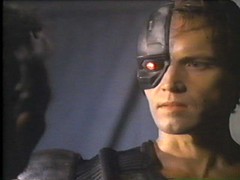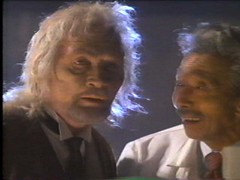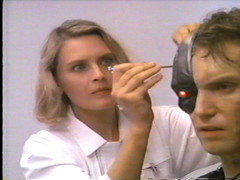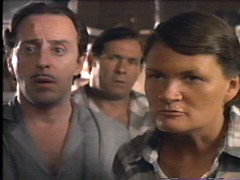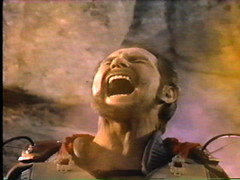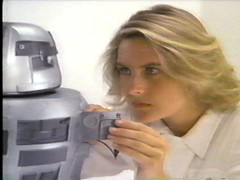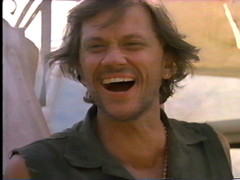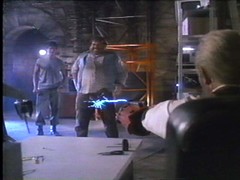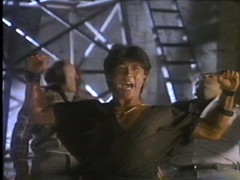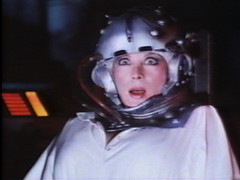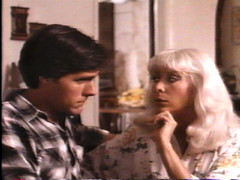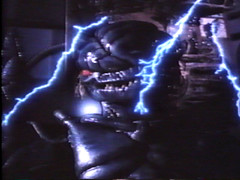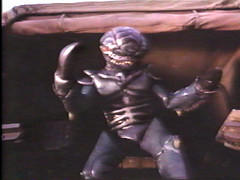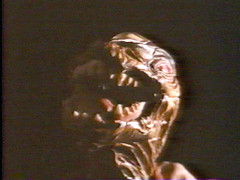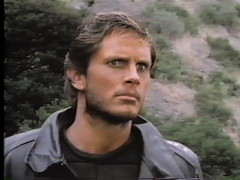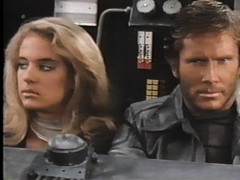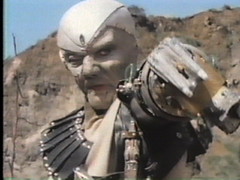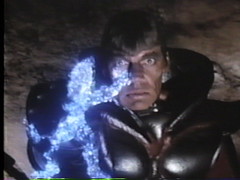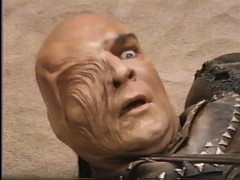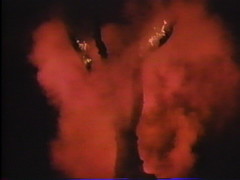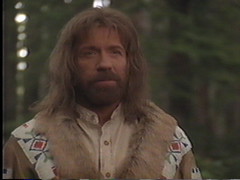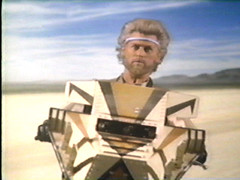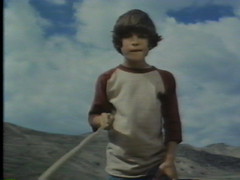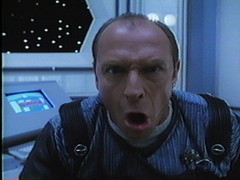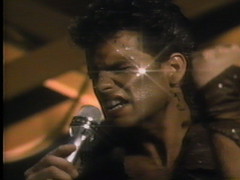Review: Eliminators (1986)
Synopsis
When a man named John crashed his plane in the jungles of Mexico, he expected to die. One thing that he most likely did NOT expect was to be pulled from the burning wreckage by a reclusive mad scientist named Abbot Reeves, brought back from the edge of death, and transformed into a hideous cyborg (or "Mandroid" as Reeves calls him.) I'm guessing he also didn't expect that Reeves would then stick him in a time machine and send him on missions into the past to bring back mint condition Roman artifacts for his collection. Life is funny, isn't it?
When Reeves has his collection completed and is finished with John the Mandroid, he instructs his assistant Dr. Takada to take him out back and give him the Ol' Yeller treatment. Takada protests, but Reeves is not the most compassionate evil genius you've ever met. Takada tries to help John escape, but Reeves' minions gun Takada down. John makes a daring escape into the jungle, but not before sustaining serious damage to his transmission.
Determined to avenge the death of his only friend (and to get back at Reeves for the whole Mandroid thing), John makes his way into the United States to track down the person whose robotics research Reeves stole in order to make him a cyborg. This person is Nora Hunter(Denise Crosby), a Colonel in the army and brilliant scientist who was unaware that Reeves was secretly funding her research and then stealing her ideas for his own nefarious purposes.
Nora is a little taken aback when a hulking cyborg in a cheap plastic poncho and rain hat comes staggering into her lab one dark night, but she listens to John's story and provides a tune-up and oil change free of charge. Feeling pretty annoyed that she's been the pawn of an evil mastermind, Nora insists that she go along with John on his revenge quest. The two set off for Mexico, John in his highly convincing disguise (the aforementioned plastic poncho and rain hat.)
Once they reach the jungle, Nora enlists the help of riverboat captain, jungle guide, and provider of comic relief Harry Fontana. Fontana knows the area, and his skinny swamp-rat appearance belies his bravery and resourcefulness. The three set off on a river that leads into the deepest Mexican jungles. Unfortunately, the other skeevy riverboat captains have no love for Fontana, and do not appreciate him stealing their would-be business.
The Fontana-haters club, led by macho lesbian Bayou Betty and her cowardly French sidekick Maurice (no, I'm not making this up) come screaming up the river hot on the trail of our heroes. Thanks to some evasive maneuvers by Fontana and Nora and, more to the point, John's torpedo-launcher arm attachment, They manage to escape. As they get closer to Reeves' base, they must also deal with his dimwitted henchmen, but this doesn't prove to be too difficult.
During one of Fontana's fancy boat turns John falls overboard, and when they are unable to find him in the mucky river bottom, Fontana and Nora must press on without him. Not surprisingly, John trudges out of the water shortly after and continues on foot. He meets a young ninja by the name of Kuji who turns out to be Dr. Takada's son, also there on a revenge quest (again, I'm not making it up). Meanwhile, Fontana and Nora are captured by a band of rogue cavemen (I know! I know!). They get away with help from John and Kuji.
With our band of heroes reunited, they plan an attack on Reeves' headquarters. The three people without robotic augmentation sneak in through an air duct while John just goes up to the front door. Nora, Fontana and Kuji determine that Reeves is planning to use his time machine to go back to Roman times and proclaim himself the new emperor. (They also realize that Reeves must have used the time machine to bring the cavemen into the present day, though nobody is able to offer an explanation of WHY.)
There's a big shootout with the good guys versus Reeves, newly fitted out with some cyborg modifications of his own, and his army of heavily-armed thugs. Things don't go so well, and John sacrifices his life to save his three compatriots from one of Reeves' evil weapons. Thinking he is in the clear, Reeves hops into his time machine and starts it running. Nora, Kuji, and Harry wander in, and when Harry punches the control console in frustration, Reeves' time destination gets completely scrambled up and he finds himself trapped in the Silurian epoch, well before the Dawn of Man. This cheers up our remaining heroes, and they are able to share a good laugh even though John is in that great scrapyard in the sky.
Comments
This bad-movie business is a funny thing. Every once in a while, I come upon a movie that practically shrieks "I AM HORRIBLE!!" Usually, it is not lying. In some cases, though, I'm surprised by how good such a film can be. Eliminators is one such film. Everything about it would suggest an eminently stupid action adventure. With a tagline that reads "Mandroid. Mercenary. Scientist. Ninja. Each one a specialist. Together they are ELIMINATORS," how could it possibly not be awful?
I was prepared to like it for being bad, but I was startled to find myself liking it for being GOOD! The script acknowledges its comic-book subject matter and avoids the trap of taking itself too seriously, but at the same time it doesn't become a farce. The acting is quite respectable for the most part, and although the special effects are hit-and-miss, the Mandroid suit is pretty impressive.
Heading up the cast is the beautiful Denise Crosby, best remembered (at least by geeks like me) as Tasha Yar from "Star Trek: the Next Generation." Her portrayal of Nora is just about perfect - between the writing and acting, Nora is one of the most well-balanced and positive female film characters I've seen in a long while. She's brilliant, tough, and compassionate, and Crosby gives her just the right mix of seriousness and humor.
John the Mandroid (Patrick Reynolds) is pleasantly stoic without being completely robotic, but the other actor who really serves to anchor the film is Andrew Prine as Harry Fontana. It's easy to relate to him, because he seems to be the only character who realizes how weird the story is. Prine has been acting, mostly in television roles, for decades, and he makes Fontana likable and funny. His interactions with Nora keep things light and energetic.
Given that Eliminators predated the much darker and more violent Robocop by a year, the Mandroid suit deserves ample credit. Given the budget constraints on a film like this, it's obvious that somebody put a lot of time and effort into the thing. It's got more attachments than a Hoover - John is constantly switching out his arms - and its coolest feature is probably the optional eighteen-wheel ATV attachment. He just pops his legs off and hooks his torso directly into the thing, becoming a sort of human tractor-trailer.
Though we don't see that much of Abbot Reeves, we do get a pretty good sense of his evilness. He doesn't lose any sleep over ordering John's death, nor does he shed a tear when his long-time assistant Takada is gunned down by accident. He gleefully attempts to vaporize Nora and company. His most chilling act of evil, however, occurs when he disciplines one of his henchmen by electrocuting the poor guy's crotch. Yikes. Reeves makes Leona Helmsley seem easy to work for.
Of course, it would be remiss of me to imply that Eliminators doesn't have its faults. The cavemen seem like a bit of a red herring. Kaji seems to have gotten his ninja training through a correspondence school. I'm not entirely clear on why Reeves would go to the trouble of turning John into the Mandroid, then want to toss him away like used dental floss. And the idea that one little whack to Reeves' computer would be enough to send his time machine spiraling several hundred-million years off course is a tad questionable. Still, I'm more than willing to overlook a few flaws in such a good-natured and enjoyable movie.
Final Analysis
Eliminators is a surprisingly well-made little comic book of a movie, with a plucky script, decent effects, and actors who seem to be enjoying themselves in their roles. If a film that combines cyborgs, ninjas, cavemen, mad scientists, good-natured mercenaries, and Tasha Yar sounds too good to be true, Eliminators is a perfect way to spend an hour and a half. Recommended.

